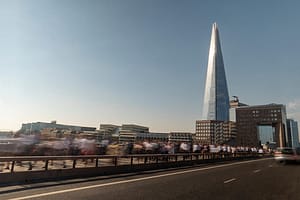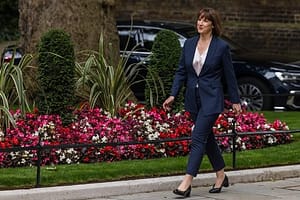Why does the motoring billionaire collect miniature Japanese sculptures and get milk delivered to his door? Our exclusive interview reveals the life behind the billions
By Christian Sylt, with Caroline Reid
As a full time Formula 1 reporter I am often asked whether it really is another world.
My answer? You don’t know the half of it mate.
The money. The champagne. The locations such as Monaco, Dubai and Singapore. The girls (hands up, this sport attracts more beautiful girls than Milan Fashion Week). And the celebrities! Where else can you see P Diddy talking to Heidi Klum? Or drink Krug with Prince Albert?
- Read part 1: Ecclestone on women, Murdoch and bribery
- Read part 2: How Bernie seized control of F1
And what about Ecclestone? By rights he ought to be the biggest playboy in the world. As ringmaster of the sport he decides who gets access to the Paddock on raceday. He’s the cappo di tutti cappi.
And yet. He’s totally not like that. In order to run a global empire you can’t be like that.
So if you want to understand the way he really operates let me take you backstage into the secret world of Bernie Ecclestone. It’s pretty bizarre in it’s own way.
He sold his home to Lakshmi Mittal for £57m making it the most expensive home in the world – and making Ecclestone a £7m profit
The truth is that Ecclestone has managed to stay in the driving seat due to his experience and dedication. He has all the toys including the obligatory private planes complete with an airport in the south of France owned by his offshore family trust, a yacht and a hotel in Gstaad. However, for any investment to pass muster it must either help him do business or cover its costs.
In 2001 his family trust bought 18 – 19 Kensington Palace Gardens in London, a palace in its own right with its own Turkish baths and marble taken from the same quarry that supplied the Taj Mahal. It wasn’t Ecclestone’s cup of tea: “I only went in it three times” he tells me. The reason for ownership was profit. And in 2004 it was sold to Europe’s richest man steel baron Lakshmi Mittal for £57m making it the most expensive house in the world at the time – a £7m profit.
Ecclestone now lives in a modestly-sized penthouse above the office meaning that it couldn’t be easier for him to get to work. True to his working class origins he even has milk delivered to his doorstep every day.
Team Ecclestone
Team Ecclestone is small and personal. F1 had revenues of $1.6bn last year and employs just over 300 staff giving it one of the highest ratios of turnover per capita of any UK company. The majority work from an office block with blacked-out windows on Princes Gate opposite Hyde park. Ecclestone bought the building from flamboyant Saudi arms dealer Adnan Khashoggi in 1985 and his frugal upbringing explains how he manages to run such a tight ship.
The waiting room to his office is littered with artwork and sculptures but two sum him up better than the rest – the first is a bronze-work of two disembodied hands gripping each other. As I discovered on being hired by him eight years ago, Ecclestone’s deals are done on a handshake. He comes from the classic entrepreneur mould so post-it notes are used instead of a PDA and he swears by fax.
Ironically, despite F1 being one of the world’s most cutting-edge sports, Ecclestone is not overly tech savvy. For example, he has his closest business contacts on speed dial but instead of using a digital address book, their numbers are printed on a list which is taped to the back of his mobile phone. In a nod to one of his favourite films, Ecclestone had his ring tone changed to Ennio Morricone’s famous theme tune to the ‘The Good, The Bad and the Ugly’.
- Read part 1: Ecclestone on women, Murdoch and bribery
- Read part 2: How Bernie seized control of F1
The other apt artefact in his collection is a model of a million dollars in stacked banknotes. His life has always revolved around money. In the late 1970s one team boss wagered his driver $1,000 that he wouldn’t push the immaculately-dressed Ecclestone into the hotel pool at as he stood beside it. The driver accepted the bet but, without telling his boss, approached Ecclestone and told him about it. Ecclestone replied: “OK – for half the money.” He then let himself get drenched but pocketed his share of the money.
Ecclestone’s only known hobby is collecting miniature Japanese sculptures
Ecclestone is skilled in steering discussions to subjects which suit him. Disarmingly, many of his responses begin with “I don’t know” often resulting in the questioner offering their opinion instead. And when meetings aren’t going in his favour he has been known to call one person outside for a private discussion making the person who is being called outside feel special, whilst tongues wag inside the meeting as to what is going on.
It seems to come naturally to Ecclestone but some is by design. F1 is one of the world’s most secretive sports. Its key companies are located offshore and it doesn’t have a PR department. This all helps to manufacture its mystique and puts even more control in Ecclestone’s hands. What he says goes.
Ecclestone’s only known hobby is collecting miniature Japanese sculptures. He is a keen poker player but it’s tough to tell whether this is to hone his negotiation skills. They have served him well. The sale of stakes in F1 has raised a total of $2.5bn (see box) which gave his family a nice nest egg but also raised its fair share of problems.
Bernie’s inbox
That’s the Bernie lifestyle.
But what is he working on? What does the man who has billions in the bank actually need to achieve?
Let me talk you through the numbers, and you’ll start to understand what he needs to do. You might start to see why he needs that his own airport.
Last year was one of the closest seasons on the track in memory and led to the crowning of Red Bull driver Sebastian Vettel as F1’s youngest-ever world champion. It fuelled a 1.3 per cent rise in F1’s global television audience which hit 527m viewers last year. According to F1’s industry guide Formula Money, which I edit, race hosting fees are the sport’s biggest revenue generator bringing in $567.5m with $470m coming from the sale of television rights, $243m from trackside advertising, $153.5m from corporate hospitality and $90.5m from sponsorship and licensing.
The sport is now thought to be worth in the region of $8bn but its value was far lower when CVC acquired it (to read how they acquired it read my last piece for LondonlovesBusiness).
CVC has had a great return on its cash.
According to Formula Money’s analysis, after making the loan repayments F1 has made net profits of $1.2bn since CVC bought it, with $800m of that being paid to CVC in line with its shareholding.
Nevertheless, the returns would have been even higher if it wasn’t for the fact that the majority of CVC’s acquisition of F1 was funded with debt. The repayments on this put constant pressure on Ecclestone to increase revenues.
Trouble is Ecclestone can’t increase the number of races anymore. The Concorde Agreement caps the number at 20 annually and it will reach this ceiling next year.
- Read part 1: Ecclestone on women, Murdoch and bribery
- Read part 2: How Bernie seized control of F1
Since Ecclestone can’t add more races to the calendar he has concentrated on getting the maximum cash out of each race. This has required him to sign deals with emerging nations who want to put themselves on the global map. Hosting an F1 race puts a country on a calendar alongside exotic and well-developed nations such as Australia, Malaysia, Japan and Monaco. It also gives them promotion to the sport’s massive TV audience.
Since the governments of these countries can use F1 to promote tourism they fund the hosting fees for their race and this has driven up the price to an average of $29.7m per Grand Prix. Last year South Korea joined the calendar, next month India comes on board and in 2014 the first F1 race in Russia will take place. Cleverly, the race hosting contracts all contain an escalator clause which increases the cost by 10 per cent annually. This brilliant pricing strategy has insulated F1 from the downturn.
But what it means is that Ecclestone must travel the globe, haggling with existing venues and negotiating with potential venues to keep revenue rising.
You can’t do that with a head full of champagne.
And it’s why Ecclestone is so highly esteemed in the sport. Yes he’s the master of ceremonies. But without him and without his limitless drive to keep the sport expanding the whole show might just grind to a halt.
Christian Sylt is a full-time writer on the finances of Formula 1. He co-edits with Caroline Reid the annual commercial guide to the sport, Formula Money, which details what every sponsor spends, driver salaries and team incomes.




Leave a Comment